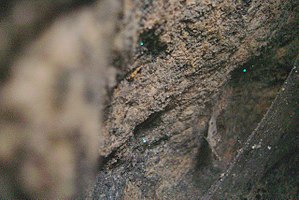This article includes a list of general references, but it lacks sufficient corresponding inline citations .(March 2015) |
 Entrance to the tunnel | |
| Overview | |
|---|---|
| Official name | Tunnel No 2 |
| Line | Newnes railway line |
| Location | Newnes plateau |
| Coordinates | 33°14′19″S150°13′36″E / 33.238727°S 150.226593°E |
| Operation | |
| Work begun | 1906 |
| Constructed | June 1907 |
| Closed | 1932 |
| Operator | Commonwealth Oil Corporation |
| Traffic | train |
| Technical | |
| Length | 20 chains (1,320.0 ft; 402.3 m) |
| No. of tracks | single |
| Track gauge | 4 ft 8+1⁄2 in (1,435 mm) standard gauge [1] |
| Grade | 1:25 |


The Glowworm Tunnel is a disused railway tunnel between Lithgow, New South Wales and Newnes, New South Wales, Australia. It is notable for its resident glow-worms, the bioluminescent larvae of Arachnocampa richardsae , a type of fungus gnat.